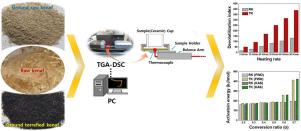当前位置:
X-MOL 学术
›
Energy Rep.
›
论文详情
Our official English website, www.x-mol.net, welcomes your
feedback! (Note: you will need to create a separate account there.)
Thermal degradation of kenaf (Hibiscus cannabinus L.): Impact of torrefaction on pyrolysis kinetics and thermal behavior
Energy Reports ( IF 4.7 ) Pub Date : 2021-02-11 , DOI: 10.1016/j.egyr.2021.01.012 Byoung-Hwa Lee , Tae-Yong Jeong , Viet Thieu Trinh , Chung-Hwan Jeon
Energy Reports ( IF 4.7 ) Pub Date : 2021-02-11 , DOI: 10.1016/j.egyr.2021.01.012 Byoung-Hwa Lee , Tae-Yong Jeong , Viet Thieu Trinh , Chung-Hwan Jeon

|
Pre-treatment of biomass has garnered significant research attention to facilitate biomass utilization. This study examines the effect of torrefaction on the pyrolysis characteristics of kenaf (.), which grows in South Korea and has a relatively short life cycle as well as a low production cost among herbaceous biomass. In this study, raw kenaf (RK) and torrefied kenaf (TK) were prepared in an inert atmosphere. Torrefaction was carried out in a bed reactor for 30 min at 503, 523 and 553 K, and pyrolysis was performed at six heating rates and analyzed using thermogravimetric analysis. The results showed that the optimal temperature for RK torrefaction based on the energy-mass co-benefit index was 523 K, owing to a higher energy density and low volume. The torrefaction and a higher heating rate resulted in the weight loss and decomposition rate (derivative thermogravimetric) curves moving to a higher temperature region, and improvement in the devolatilization index of the TK. The activation energy was calculated using three methods (Kissinger, Flynn–Wall–Ozawa, and Kissinger–Akahira–Sunose), with all indicating that the activation energy of the TK was greater than that of RK. Additionally, in terms of thermodynamic parameters, the TK had a higher frequency factor, higher enthalpy, slightly lower Gibbs free energy, and higher entropy than those of RK. These kinetic and thermal behavior results are useful for designing pyrolysis processes wherein TK is used as a feedstock; moreover, they provide a useful reference for TK heat conversion applications.
中文翻译:

红麻(Hibiscus cannabinus L.)的热降解:烘焙对热解动力学和热行为的影响
生物质的预处理已引起了研究人员的广泛关注,以促进生物质的利用。本研究探讨了烘焙对红麻 (.) 热解特性的影响,红麻生长在韩国,在草本生物质中生命周期相对较短,生产成本较低。在这项研究中,生红麻 (RK) 和烘焙红麻 (TK) 在惰性气氛中制备。在床反应器中在 503、523 和 553 K 下进行烘焙 30 分钟,并在六种加热速率下进行热解并使用热重分析进行分析。结果表明,基于能量-质量协同效益指数的RK烘焙最佳温度为523 K,因为其具有较高的能量密度和较小的体积。烘焙和较高的加热速率导致重量损失和分解速率(导数热重)曲线移至较高温度区域,并提高了 TK 的脱挥发分指数。使用三种方法(Kissinger、Flynn-Wall-Ozawa 和 Kissinger-Akahira-Sunose)计算活化能,均表明 TK 的活化能大于 RK。此外,在热力学参数方面,TK比RK具有更高的频率因子、更高的焓、略低的吉布斯自由能和更高的熵。这些动力学和热行为结果可用于设计热解过程,其中 TK 用作原料;此外,它们为TK热转换应用提供了有用的参考。
更新日期:2021-02-11
中文翻译:

红麻(Hibiscus cannabinus L.)的热降解:烘焙对热解动力学和热行为的影响
生物质的预处理已引起了研究人员的广泛关注,以促进生物质的利用。本研究探讨了烘焙对红麻 (.) 热解特性的影响,红麻生长在韩国,在草本生物质中生命周期相对较短,生产成本较低。在这项研究中,生红麻 (RK) 和烘焙红麻 (TK) 在惰性气氛中制备。在床反应器中在 503、523 和 553 K 下进行烘焙 30 分钟,并在六种加热速率下进行热解并使用热重分析进行分析。结果表明,基于能量-质量协同效益指数的RK烘焙最佳温度为523 K,因为其具有较高的能量密度和较小的体积。烘焙和较高的加热速率导致重量损失和分解速率(导数热重)曲线移至较高温度区域,并提高了 TK 的脱挥发分指数。使用三种方法(Kissinger、Flynn-Wall-Ozawa 和 Kissinger-Akahira-Sunose)计算活化能,均表明 TK 的活化能大于 RK。此外,在热力学参数方面,TK比RK具有更高的频率因子、更高的焓、略低的吉布斯自由能和更高的熵。这些动力学和热行为结果可用于设计热解过程,其中 TK 用作原料;此外,它们为TK热转换应用提供了有用的参考。











































 京公网安备 11010802027423号
京公网安备 11010802027423号